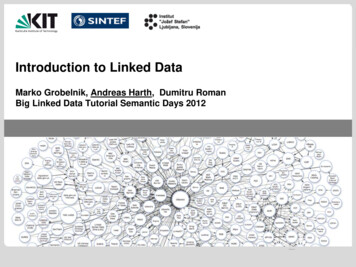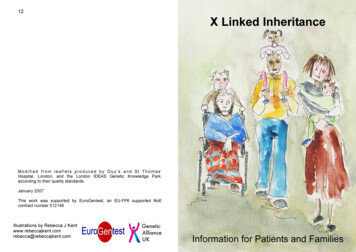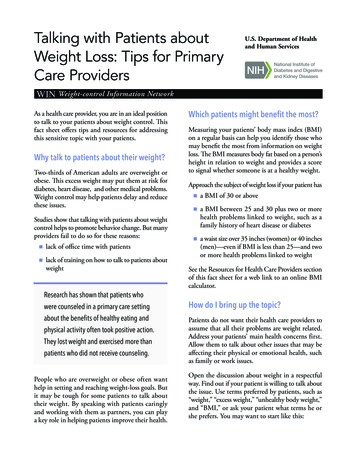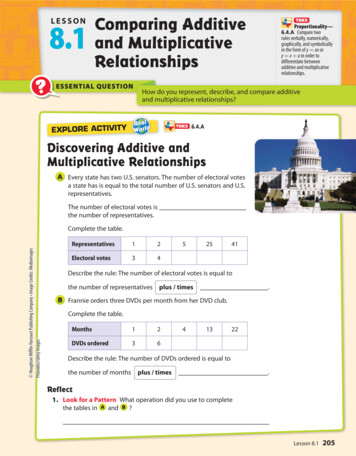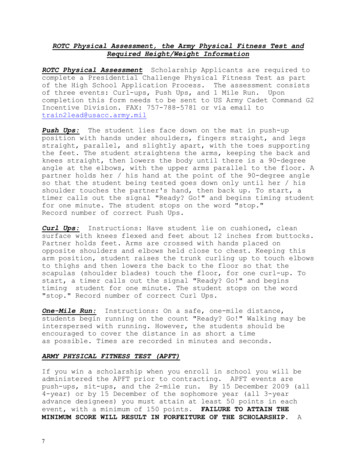
Transcription
Triplify – Light-Weight Linked Data Publication fromRelational DatabasesSören Auer, Sebastian Dietzold, Jens Lehmann,Sebastian Hellmann, David AumuellerUniversität Leipzig, Postfach 100920, 04009 Leipzig, Germany{auer dietzold lehmann hellmann aumueller}@informatik.uni-leipzig.deABSTRACTIn this paper we present Triplify – a simplistic but effectiveapproach to publish Linked Data from relational databases.Triplify is based on mapping HTTP-URI requests onto relational database queries. Triplify transforms the resulting relations into RDF statements and publishes the dataon the Web in various RDF serializations, in particular asLinked Data. The rationale for developing Triplify is thatthe largest part of information on the Web is already storedin structured form, often as data contained in relationaldatabases, but usually published by Web applications onlyas HTML mixing structure, layout and content. In orderto reveal the pure structured information behind the current Web, we have implemented Triplify as a light-weightsoftware component, which can be easily integrated intoand deployed by the numerous, widely installed Web applications. Our approach includes a method for publishingupdate logs to enable incremental crawling of linked datasources. Triplify is complemented by a library of configurations for common relational schemata and a REST-enableddata source registry. Triplify configurations containing mappings are provided for many popular Web applications, including osCommerce, WordPress, Drupal, Gallery, and phpBB. We will show that despite its light-weight architecture Triplify is usable to publish very large datasets, such as160GB of geo data from the OpenStreetMap project.Categories and Subject Descriptorsrepresentations is (as we will show in the next section) stilloutpaced by the growth of traditional Web pages and onemight remain skeptical about the potential success of the Semantic Web in general. The missing spark for expanding theSemantic Web is to overcome the chicken-and-egg dilemmabetween missing semantic representations and search facilities on the Web.In this paper we, therefore, present Triplify – an approachto leverage relational representations behind existing Webapplications. The vast majority of Web content is alreadygenerated by database-driven Web applications. These applications are often implemented in scripting languages suchas PHP, Perl, Python, or Ruby. Almost always relationaldatabases are used to store data persistently. The mostpopular DBMS for Web applications is MySQL. However,the structure and semantics encoded in relational databaseschemes are unfortunately often neither accessible to Websearch engines and mashups nor available for Web data integration.Aiming at a larger deployment of semantic technologieson the Web with Triplify, we specifically intend to: enable Web developers to publish easily RDF triples,Linked Data, JSON, or CSV from existing Web applications, offer pre-configured mappings to a variety of popular Web applications such as WordPress, Gallery, andDrupal,H.3.4 [Systems and Software]: Distributed systems; H.3.5[Online Information Services]: Data sharing allow data harvesters to retrieve selectively updatesto published content without the need to re-crawl unchanged content,General Terms showcase the flexibility and scalability of the approachwith the example of 160 GB of semantically annotatedgeo data that is published from the OpenStreetMapproject.Algorithms, LanguagesKeywordsData Web, Databases, Geo data, Linked Data, RDF, SQL,Semantic Web, Web application1.INTRODUCTIONEven though significant research and development effortshave been undertaken, the vision of an ubiquitous SemanticWeb has not yet become reality. The growth of semanticCopyright is held by the International World Wide Web Conference Committee (IW3C2). Distribution of these papers is limited to classroom use,and personal use by others.WWW 2009, April 20–24, 2009, Madrid, Spain.ACM 978-1-60558-487-4/09/04.The importance of revealing relational data and making itavailable as RDF and, more recently, as Linked Data [2, 3]has been recognized already. Most notably, Virtuoso RDFviews [5, 9] and D2RQ [4] are production-ready tools for generating RDF representations from relational database content. A variety of other approaches has been presented recently (cf. Section 6). Some of them even aim at automating partially the generation of suitable mappings from relations to RDF vocabularies. However, the growth of semanticrepresentations on the Web still lacks sufficient momentum.From our point of view, a major reason for the lack of deployment of these tools and approaches lies in the complexity
ProjectphpBBGalleryLiferay Areadiscussion forumphoto galleryPortalphoto galleryCMSCMSgroup wareCMSCMSCMSBloggingCalendarERP ,52210,0925,490Table 1: The 15 most popular database-backed webapplication projects as hosted at Sourceforge.netand ordered by download count in September 2008.of generating mappings. Tools which automate the generation of mappings fail frequently in creating production-readymappings. Obstacles, for example, include: Identification of private and public data. Web applications always contain information which should notbe made public on the Web such as passwords, emailaddresses or technical parameters and configurations.Automatically distinguishing between strictly confidential, important and less relevant information is veryhard, if not impossible. Proper reuse of existing vocabularies. Even the mostelaborated approaches to ontology mapping fail in generating certain mappings between the database entities(table and column names) and existing RDF vocabularies, due to lacking machine-readable descriptions ofthe domain semantics in the database schema. Missing database schema descriptions. Many databaseschemas used in Web applications lack comprehensivedefinitions for foreign keys or constraints, for example.Syntactic approaches for detecting these are likely tofail, since database schemas are often grown evolutionary and naming conventions are often not enforced.Taking these obstacles into account, the entrance barrier for publishing database content as RDF appears to bevery high. On the other hand, Web applications are oftendeployed a thousand (if not a million) times on the Web(cf. Table 1) and database schemas of Web applicationsare significantly simpler than those of ERP systems, for instance. Likewise, Web application developers and administrators usually have decent knowledge of relational databasetechnologies, in particular of SQL.The rationale behind Triplify is to provide for a specifically tailored RDB-to-RDF mapping solution for Web applications. The ultimate aim of the approach is to lower theentrance barrier for Web application developers as much aspossible. In order to do so, Triplify neither defines nor requires to use a new mapping language, but exploits andextends certain SQL notions with suitable conventions fortransforming database query results (or views) into RDFand Linked Data.Once a large number of relational data is published onthe Web, the problem of tracing updates of this data becomes paramount for crawlers and indexes. Hence, Triplifyis complemented by an approach for publishing update logsof relational databases as Linked Data, essentially employing the same mechanisms. Triplify is also accompanied witha repository for Triplify configurations in order to facilitatereuse and deployment, and with a light-weight registry forTriplify and Linked Data endpoints. We tested and evaluated Triplify by integrating it into a number of popular Webapplications. Additionally, we employed Triplify to publish the 160GB of geo data collected by the OpenStreetMapproject.The paper is structured as follows: We motivate the needfor a simple RDB-to-RDF mapping solution in Section 2 bycomparing indicators for the growth of the Semantic Webwith those for the Web. We present the technical conceptbehind Triplify in Section 3. Our implementation is introduced in Section 4. We discuss the evaluation of Triplifyin small- and large-scale scenarios in Section 5, present acomprehensive overview on related work in Section 6, andconclude with an outlook on future work in Section 7.2.CURRENT GROWTH OF THE SEMANTIC WEBOne of the ideas behind Triplify is to enable a large number of applications and people to take part in the SemanticWeb. We argue that the number of different stakeholdersneeds to increase in order to realise the vision of the Semantic Web. This means in particular that we need not onlylarge knowledge bases, but also data created by many smalldata publishers. Although it is difficult to give a rigorousproof for such a claim, we observed a few interesting facts,when analysing the growth of the Semantic Web, in particular in relation to the World Wide Web.Some statistics are summarized in Figure 2. The red linein the figure depicts the growth of the WWW measuredby the number of indexed pages on major search engines.This estimate is computed by extrapolating the total number of pages in a search engines index from known or computed word frequencies of common words1 . Along the line ofsimilar studies, the statistics suggest an exponential growthof pages on the WWW. The number of hosts2 (green line)grows slower, while still being roughly exponential3 .We tried to relate this to the growth of the Semantic Web.The currently most complete index of Semantic Web data isprobably Sindice4 . It stores 37.72 million documents, whichaccounts for slightly more than 0.1% of all WWW documents. Since the growth of documents in Sindice was closelyrelated to upgrades in their technical infrastructure in thepast, we cannot reliably use their growth rate. However, theabsolute number indicates that semantic representations arenot yet common in today’s Web.Another semantic search engine is Swoogle5 . The blue1see http://www.worldwidewebsize.comstatistics from http://isc.org3see http://www.isc.org/ops/ds/hosts.png for a long c.edu/2
Figure 1: Temporal comparison of different growth indicators for the traditional WWWand the Semantic Data Web.The first and second linesshow statistics for indexedweb pages (obtained fromWorldWideWebSize.com) andhosts (obtained from isc.org)for the WWW. The thirdand fourth lines are countsof Semantic Web documentsfrom Swoogle (obtained fromSwooglepublicationsandswoogle.umbc.edu) and PingThe Semantic Web (obtainedby log file analysis). Pleasenote the different order ofmagnitude for each line.40indexed WWW pages in billionsWWW hosts in 100 millionsSwoogle SWDs millionsPTSW documents in 100 thousands35(109 )(108 )(106 )(105 arline in Figure 2 illustrates the growth in Semantic Web documents (SWDs) in the Swoogle index. It indexed 1.5 milliondocuments from the start of Swoogle early in 2005 until themiddle of 2006. Currently (October 2008), 2.7 million documents are indexed. Note that Swoogle, unlike Sindice, doesnot crawl large ontologies as present in the Linking OpenData (LOD) cloud. If we take this aspect into account, theSemantic Web growth curve would be steeper. However,the LOD data sets are usually very large data sets extractedfrom single sources. A growth of the LOD cloud does notindicate that the number of different participants in the Semantic Web would itself be high.We also analysed Ping the Semantic Web (PTSW)6 logfiles since they started logging (last line). Apart from thestartup phase (i.e. all documents collected so far fall in thefirst months), we observed an approximately linear growthof about 15.000 new resources pinged each month over thefollowing 14 months. Overall, our observations – while theyhave to be interpreted very carefully – indicate that the number of data publishers in the Semantic Web is still someorders of magnitudes lower than those in the WWW. Furthermore, its relatively low (estimated) growth rate showsthat simple ways need to be found for a larger number ofweb applications to take part in the Semantic Web.A recent study [7] analysed how terms (classes and properties) depend on each other in the current Semantic Web.They used a large data set collected by the Falcons semantic search engine7 consisting of more than 1.2 million termsand 3.000 vocabularies. By analysing the term dependencygraph, they concluded that the “schema-level of the Semantic Web is still far away from a Web of interlinked ontologies,which indicates that ontologies are rarely reused and it willlead to difficulties for data integration.”. Along similar lines,[8] analysed a corpus of 1.7 million Semantic Web documentswith more than 300 million triples. They found that 95%of the terms are not used on an instance level. Most u.edu.cn/services/falcons/are from meta-level (RDF, RDFS, OWL) or a few popular(FOAF, DC, RSS) ontologies. By enabling users to map onexisting vocabularies, Triplify encourages the re-use of termsand will thereby contribute positively to data integration onthe Semantic Web even on the schema level.3.THE CONCEPTTriplify is based on the definition of relational databaseviews for a specific Web application (or more general fora specific relational database schema) in order to retrievevaluable information and to convert the results of thesequeries into RDF, JSON and Linked Data. Our experiencesshowed that for most Web applications a relatively smallnumber of simple queries (usually between 5 to 20) is sufficient to extract the important public information containedin a database. After generating such views, the Triplify toolis used to convert them into an RDF, JSON or Linked Datarepresentation (explained in more detail later), which can beshared and accessed on the Web. The generation of thesesemantic representations can be performed on demand or inadvance (ETL). An overview of Triplify in the context ofcurrent Web technologies is depicted in Figure 2.3.1Triplify ConfigurationAt the core of the Triplify concept is the definition ofa configuration adapted for a certain database schema. Aconfiguration contains all the information the Triplify implementation needs in order to generate sets of RDF tripleswhich are returned on a URI requests it receives via HTTP.The Triplify configuration is defined as follows:Definition 1 (Triplify configuration) A Triplify configuration is a triple (s, φ, µ) where: s is a default schema namespace, φ is a mapping of namespace prefixes to namespaceURIs,
Keyword-basedSearch EnginesWeb BrowserHTML pagesRDF tripletriple-basedbased descriptions(Linked Data, RDF, JSON)WebserverWeb Applicationrequires any additional knowledge and allows users toemploy semantic technologies, while working in a familiar environment.Semantic-basedSemanticbasedSearch EnginesEndpointregistryTriplify script3.2Relational View StructureFor converting SQL query results into the RDF data model,Triplify follows a multiple-table-to-class approach precededby a relational data transformation. Hence, the results ofthe relational data transformation require a certain structure in order to be representable in oryFigure 2: Triplify overview: the Triplify script isaccompanied with a configuration repository and anendpoint registry. µ is a mapping of URL patterns to sets of SQL queries;individual queries can optionally contain placeholdersreferring to parenthesized sub-patterns in the corresponding URL pattern.The default schema namespace s is used for creating URIidentifiers for database view columns, which are not mappedto existing vocabularies. Since the same Triplify configuration can be used for all installations of Web applications withthe same database storage layout, data from across these different installations can be already integrated even withouta mapping to existing vocabularies. The namespace prefixto URI map φ in the Triplify configuration defines shortcutsfor frequently used namespaces. The mapping µ maps dereferencable RDF resources to sets of SQL views describingthese resources. The patterns in the domain of µ will beevaluated against URI requests Triplify receives via HTTP.The Triplify extraction algorithm replaces placeholders inthe SQL queries with matches of parenthesized sub-patternsin the URL patterns of µ. For the purpose of simplicity, ourimplementation (which we discuss in more detail later) doesnot require the use of patterns and placeholders at all, andis still sufficient for the vast majority of usage scenarios. Asimple example of µ for the WordPress blogging system isdisplayed in Figure 3.The use of SQL as a mapping language has many advantages compared with employing newly developed mappinglanguages: SQL is a mature language, which was specifically developed to transform between relational structures (results of queries are also relational structures). Hence,SQL supports many features, which are currently notavailable in other DB to RDF mapping approaches.Examples are aggregation and grouping functions orcomplex joins. Being based on SQL views allows Triplify to push almost all expensive operations down to the database.Databases are heavily optimized for data indexing andretrieval, thus positively affecting the overall scalability of Triplify. Nearly all software developers and many server administrators are proficient in SQL. Using Triplify barely The first column of each view must contain an identifier which will be used to generate instance URIs. Thisidentifier can be, for example, the primary key of thedatabase table. Column names of the resulting views will be used togenerate property URIs. Individual cells of the query result contain data values or references to other instances and will eventuallyconstitute the objects of resulting triples.In order to be able to convert the SQL views defined in theTriplify configuration into the RDF data model, the viewscan be annotated inline using some extensions to SQL, whichremain transparent to the SQL processor, but influence thequery result, in particular the column names of the returnedrelations.When renaming query result column names, the followingextensions to SQL can be used to direct Triplify to employexisting RDF vocabularies and to export characteristics ofthe triple objects obtained from the respective column: Mapping to existing vocabularies. By renaming thecolumns of the query result, properties from existingvocabularies can be easily reused. To facilitate readability, the namespace prefixes defined in the Triplifyconfiguration in φ can be used. In the following query,for example, values from the name column from a userstable are mapped to the name property of the FOAFnamespace:SELECT id, name AS ’foaf:name’ FROM users Object properties. By default all properties are considered to be datatype properties and cells from theresult set are converted into RDF literals. By appending a reference to another instance set separated with’- ’ to the column name, Triplify will use the columnvalues to generate URIs (i.e. RDF links). Datatypes. Triplify uses SQL introspection to retrieveautomatically the datatype of a certain column andcreate RDF literals with matching XSD datatypes. Inorder to tweak this behaviour, the same technique ofappending hints to column names can be used for instructing Triplify to generate RDF literals of a certaindatatype. The used separator is ’ ’. Language tags. All string literals resulting from a result set column can be tagged with a language tag thatis appended to the column name separated with ’@’.The use of these SQL extensions is illustrated in the following example:
triplify[’queries’] array(’post’ array("SELECT id, post author AS ’sioc:has creator- user’, post date AS ’dcterms:created’, post title AS ’dc:title’,post content AS ’sioc:content’, post modified AS ’dcterms:modified’FROM posts WHERE post status ’publish’","SELECT post id AS id, tag id AS ’tag:taggedWithTag- tag’ FROM post2tag","SELECT post id AS id, category id AS ’belongsToCategory- category’ FROM post2cat",),’tag’ "SELECT tag ID AS id, tag AS ’tag:tagName’ FROM tags",’category’ "SELECT cat ID AS id, cat name AS ’skos:prefLabel’, category parent AS ’skos:narrower- category’FROM categories",’user’ array("SELECT id, user login AS ’foaf:accountName’, user url AS ’foaf:homepage’,SHA(CONCAT(’mailto:’,user email)) AS ’foaf:mbox sha1sum’, display name AS ’foaf:name’FROM users","SELECT user id AS id, meta value AS ’foaf:firstName’ FROM usermeta WHERE meta key ’first name’","SELECT user id AS id, meta value AS ’foaf:family name’ FROM usermeta WHERE meta key ’last name’",),’comment’ "SELECT comment ID AS id, comment post id AS ’sioc:reply of- user’, comment author AS ’foaf:name’,comment author url AS ’foaf:homepage’, SHA(CONCAT(’mailto:’,comment author email)) AS ’foaf:mbox sha1sum’,comment type, comment date AS ’dcterms:created’, comment content AS ’sioc:content’, comment karma,FROM comments WHERE comment approved ’1’",);Figure 3: Mapping µ from URL patterns to SQL query (sets) in the Triplify configuration for the WordPressblogging system (PHP code).Example 1 (SQL extensions) The following query, illustrating the Triplify SQL extensions, selects information froma products table. The used Triplify column naming extensions will result in the creation of literals of type xsd:decimalfor the price column, in the mapping of the values in thedesc column to literals with ’en’ language tag attached tordfs:label properties and in object property instances ofthe property belongsToCategory referring to category instances for values in the cat column.SELECT id,price AS ’price xsd:decimal’,desc AS ’rdfs:label@en’,cat AS ’belongsToCategory- category’FROM products3.3Triple ExtractionThe conversion of database content into RDF triples canbe performed on demand (i.e. when a URL in the Triplifynamespace is accessed) or in advance, according to the ETLparadigm (Extract-Transform-Load). In the first case, theTriplify script searches a matching URL pattern for the requested URL, replaces potential placeholders in the associated SQL queries with matching parts in the request URL,issues the queries and transforms the returned results intoRDF (cf. Algorithm 1). The processing steps of the algorithm are depicted in Figure 4, using the example of theWordPress Triplify configuration from Figure 3.Linked Data Generation. The Linked Data paradigmis based on the idea of making URIs used in RDF documentsde-referencable – i.e. accessible via the HTTP protocol. Theresult of such an HTTP request delivers a description ofthe resource identified by the URI, i.e. a collection of allrelevant information about the resource. The Linked Dataparadigm of publishing RDF solves several important issues:(a) the provenance of facts expressed in RDF can be easilyverified, since the used URIs always contain authoritativeinformation in terms of the publishing server’s domain name,(b) the (continuing) validity of facts can be easily verifiedby (re-)retrieving the RDF description, (c) Web crawlers canobtain information in small chunks and follow RDF links togather additional, linked information.Triplify generates Linked Data with the possibility to publish data on different levels of a URL hierarchy. On the toplevel Triplify publishes only links to classes (endpoint request). An URI of an endpoint request usually looks asfollows: http://myblog.de/triplify/. From the class descriptions RDF links point to individual instances (class request). An URI of a class request would then look like this:http://myblog.de/triplify/posts. Individual instancesfrom the classes could be finally accessed by appending theid of the instance, e.g. :http://myblog.de/triplify/posts/13.In order to simplify this process of generating Linked Data,Triplify allows to use the class names as URL patterns inthe Triplify configuration. From the SQL queries associatedwith those class names (base SQL queries) in the configuration, Triplify derives queries for retrieving lists of instancesand for retrieving individual instance descriptions. The baseSQL view just selects all relevant information about all instances. In order to obtain a query returning a list of instances, the base view is projected onto the first column(i.e. the id column). In order to obtain a query retrievingall relevant information about one individual instance, anSQL-where-clause restricting the query to the id of the requested instance is appended. In most cases this simplifiesthe creation of Triplify configurations enormously.3.4Linked Data Update LogsWhen data is published on the Web, for example as LinkedData, it is important to keep track of data (and hence RDF)updates so that crawlers know what has changed (after thelast crawl) and should be re-retrieved from that endpoint.A centralized registry (such as implemented by PingTheSemanticWeb service8 ) does not seem to be feasible, whenLinked Data becomes more popular. A centralized service,8http://pingthesemanticweb.com/
Algorithm 1: Triple Extraction AlgorithmInput: request URL, Triplify configurationOutput: set T of triples1 foreach URL pattern from Triplify configuration do2if request URL represents endpoint request then3T T {RDF link to class request for URLpattern}4else5if request URL matches URL pattern then6foreach SQL query template associated withURL pattern do7Query replacePlaceholder(URLpattern, SQL query template, requestURL);8if request URL represents class requestthen9Query projectToFirstColumn(Query);10else11if request URL represents instancerequest then12Query addWhereClause(Query,instanceId);Result execute(Query);T T convert(Result);131415return Twhich also constitutes a Single Point of Failure, will hardlybe able to handle millions of Linked Data endpoints pingingsuch a registry each time a small change occurs.The approach Triplify follows are Linked Data UpdateLogs. Each Linked Data endpoint provides information aboutupdates performed in a certain timespan as a special LinkedData source. Updates occurring within a certain timespanare grouped into nested update collections. The coarsestupdate collections cover years, which in turn contain update collections covering months, which again contain dailyupdate collections and this process of nesting collections iscontinued until we reach update collections covering secondsin time. Update collections covering seconds are the mostfine-grained update collections and contain RDF links toall Linked Data resources updated within this period oftime. For very frequently updated LOD endpoints (e.g.Wikipedia) this interval of one second will be small enough,so the related update information can still be easily retrieved. For rarely updated LOD endpoints (e.g. a personal Weblog) links should only point to non-empty updatecollections in order to prevent crawlers from performing unnecessary HTTP requests. Individual updates are identifiedby a sequential identifier. Arbitrary metadata can be attached to these updates, such as the time of the update ora certain person who performed the update.Example 2 (Nested Linked Data Update Log) Let usassume myBlog.de is a popular WordPress blog. The Triplifyendpoint is reachable via http://myBlog.de/lod/. Newblog posts, comments, and updates of existing ones are published in the special namespace below http://myBlog.de/lod/updates. Retrieving http://myBlog.de/lod/update,HTTP Request: http://blog.aksw.org/triplify/post/1SQL generation1idsioc:has creator152dc:titlesioc:contentDBpedia releaseToday we released ia134Release 3.Triple g aksw og.aksw.org/triplify/post/123.10.08sioc:has w DBpedia release”“Today we released ”“20081020T1635” xsd:dateTime“20081020T1635” //blog.aksw.org/triplify/category/34Linked Data WebFigure 4: Triple generation from database views.The numbered query result relations correspond tothe queries defined for the post URL pattern in theWordPress example configuration in Figure 3.for example, will return the following :UpdateCollection dateCollection .Each update collection should be additionally annotatedwith the timeframe it covers (which we omit here for reasonsof brevity), to avoid the need for an interpretation of theURI structure. The following RDF could then be returnedfor on e:UpdateCollection .This nesting continues until we finally reach an URL whichexposes all blog updates performed in a certain second intime. The resource http://myBlog.de/lod/update/2008/Jan/01/17/58/06 then would, for example, contain RDFlinks (and additional metadata) to the Linked Data documents updated on Jan 1st, 2008 at 7/58/06/user123update:updatedResource 080101T17:58:06" xsd:dateTime ;update:updatedByhttp://myBlog.de/lod/user/John .Invocation. Triplify automatically generates all the resources in the update
PHP-Fusion CMS 27,090 Alfresco CMS 19,851 e107 CMS 19,420 Lifetype Blogging 16,867 WebCalendar Calendar 11,776 Compiere ERP CRM 11,522 Tikiwiki Wiki 10,092 Nucleus Blogging 5,490 Table 1: The 15 most popular database-backed web application projects as hosted at Sourceforge.net and ordered by download count in September 2008. of generating .

